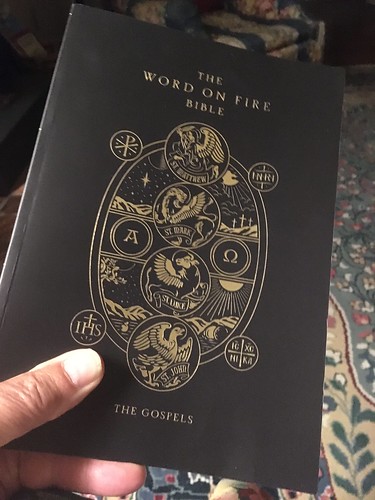
Volume XIX, Issue II: The Way of Beauty
VIA PULCHRITUDINIS
Bishop Robert Barron's Word on Fire Bible offers a beautiful presentation of the Gospels. It is written primarily for the seeker.

Bishop Robert Barron offers a new printing of the Gospels.
Bishop Robert Barron talks about his introduction to baseball as a young boy. His father took him to a Detroit Tigers game – a night game! Coming out of the tunnel into the stands, he was struck by the beauty of the freshly mowed and limed field, the crisp white home uniforms, the confident throw of the fielders – the BEAUTY of the game! That is what lead him to want to play. He signed up for T-Ball and played through high school. The Greeks knew all about the beauty of athletics. There is a certain wonder that draws a young heart to want to play.
Likewise, the Christian Faith is a Beautiful Thing! The God who redeems us has invaded our sordid history with a work of BEAUTY! Our Redemption! Bishop Barron is moved by the sublime. He also laments our tendency to try to get young people to grasp the TRUTH of our Faith when they are resistant to absolutes in general. It might be best first to show them the great beauty of Faith and Redemption. Then it is easier to grasp the workings of it. Barron uses a great example, the “Infield Fly Rule” to illustrate how we might be too concerned to teach rules before building the beautiful relationship.
Indeed, Robert’s coach got the players to get down on the grass, smell the earth and take in the feel of the turf. They couldn’t be afraid to dive into it later after a difficult catch! And so Bishop Barron states, in the simplest of terms, the reason he compiled the ‘Word on Fire Bible.’ Beginning with the four Gospels, Bishop Barron presents the Gospel in a contextual setting – great commentary – great art – that support the mission of allowing a seeker to experience the BEAUTY of the Gospel.
Too often today art does not seek to elevate our experience. Roger Scruton saw much of the Twentieth Century’s art seeking more to disturb. He used the example of ‘art’pieces that were really more of a protest of Tony Blair’s policies than an attempt to draw the viewer higher. They could have just as easily been the current yellow block letters on the black street – more the work of the poster club than true transcendent art. Fortunately Scruton and Barron see the ability of art to be truly transformative. In Robert Barron’s ‘Word on Fire Bible,’ art leads us to appreciate the Divine.
Barron asserts that there is a true Objective Beauty and that it indeed opens the door for us to experience Objective Truth. This standard of the objective is necessary if we are going to choose wisely between Heaven and Hell. A worldview that relegates all to the realm of the subjective is ill equipped to lead us.

The Story
God's Great Love Affair with Humanity
God goes to great lengths to rescue lost and hurting people. That is what The Story is all about: the story of the Bible, God's great love affair with humanity. Condensed into 31 accessible chapters, The Story sweeps you into the unfolding progression of Bible characters and events from Genesis to Revelation. Using the clear, accessible text of the NIV Bible, it allows the stories, poems, and teachings of the Bible to read like a novel. And like any good story, The Story is filled with intrigue, drama, conflict, romance, and redemption; and this story's true From the foreword by Max Lucado and Randy Frazee: "This book tells the grandest, most compelling story of all time: the story of a true God who loves his children, who established for them a way of salvation and provided a route to eternity. Each story in these 31 chapters reveals the God of grace---the God who speaks; the God who acts; the God who listens; the God whose love for his people culminated in his sacrifice of Jesus, his only Son, to atone for the sins of humanity." Learn more about this whole-church experience at TheStory.com.
Catholicism and Beauty
By Bishop Robert Barron
A refreshing perspective on the place of the beautiful in leading to Faith.
Why Beauty Matters
Roger Scruton

A woman smears black paint over the block letters painted on Fifth Avenue chanting “RE-Fund the police.”
In our town there is a frame on the side of a building, framing nothing but a brick wall. Someone wrote “What is Art?” in chalk, inside the frame. It is a great conversation piece. As historical works in sculpture have been vandalized and toppled, the same people who have tried to strip the public square of public art have created what they call their own ‘art.’ Painting large yellow letters on the public street, they proclaim the painting of murals. These are NOT murals, they are signs. They proclaim a message, true, but then so do advertisements. Ironically, not everyone these anarchists purport to represent agrees with their ‘Defund the Police’ message. A woman (above) clearly in disagreement with this sentiment smeared black paint on the… ‘Lettering.’ The news reports that the ‘mural’ is ‘vandalized,’ but who are the vandals really? Haven't we already seen the work of vandals as our city centers have been wrecked and monuments indiscriminately toppled?
Indeed, art may be employed in the making of a statement. Some advertising illustration may indeed be considered art, but when the art in question is simply a neat tagging of the street instead of bubble letters, we need to ask the question “What is Art?” If the Iconoclasts, after trashing the public square, now see THEIR work defaced, there is room for discussion.
Next week THYME will present more discussion on the question “What is Art?” and present our own mural concept. Michelangelo Buonarroti was a painter, sculptor, architect and poet widely considered one of the most brilliant artists of the Italian Renaissance. At 25 he carved the magnificent Pieta as a commission for Cardinal Jean Bilhères de Lagraulas, completing the work in less than a year! This treasure of the Vatican was exhibited at the New York World’s Fair in 1964 at the Vatican Pavilion. Between 1501 and 1504, Michelangelo took over a commission for a statue of David, which two other sculptors had abandoned. We will consider his work as we ponder further the qualities of great art.

What is Art?

Roger Scruton points out that art has in the Modern era largely given up its mission of creating beauty and has become more focused on shock and delivery of a message, much like an advertisement. As historical and representational art have fallen from favor, a more 'in your face' presentation seeks to replace the old forms. When it becomes vandalized, there is a certain irony because such works themselves appear as vandalism...

...compared to Renaissance Masterworks such as Sandro Boticelli's Birth of Venus...

...or Michelangelo's David.
(to be continued next week).
Consider the Lillies
Photos by Bob Kirchman



